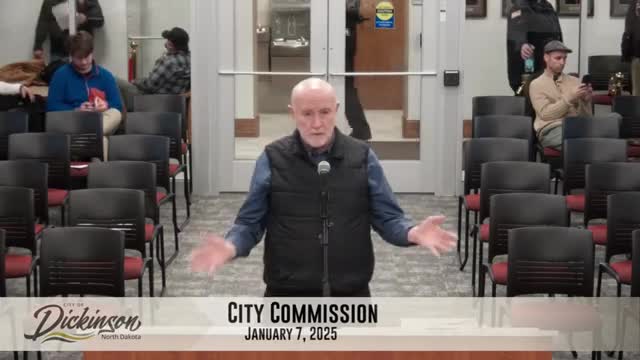Expert warns of impending grand solar minimum and its potential impact on climate and economy
January 07, 2025 | Dickinson City, Stark County, North Dakota
This article was created by AI summarizing key points discussed. AI makes mistakes, so for full details and context, please refer to the video of the full meeting. Please report any errors so we can fix them. Report an error »

During the Dickinson City Commission meeting on January 7, 2025, a significant presentation highlighted the potential impacts of a grand solar minimum on the community and the environment. The speaker emphasized that the sun plays a crucial role in influencing weather patterns, economic stability, and overall well-being.
The presentation outlined that we are currently experiencing a grand solar minimum, a period characterized by a significant reduction in sunspot activity, which is expected to last from 2020 to 2052. This phenomenon could lead to colder winters, unstable weather patterns, and an increase in volcanic and seismic activity. The speaker warned that these changes might result in food shortages projected between 2028 and 2042, urging the need for intergovernmental cooperation to mitigate potential disasters.
The discussion also touched on historical cycles of solar activity, noting that the last grand solar minimum occurred 350 years ago. The speaker referenced research from a Ukrainian scientist who developed a formula predicting solar cycles with 97% accuracy, underscoring the urgency of preparing for the anticipated climatic shifts.
In addition to the environmental concerns, the speaker linked solar cycles to broader societal issues, suggesting that periods of solar minimum have historically coincided with economic downturns and social unrest. The meeting concluded with a call for the community to be proactive in addressing these challenges, emphasizing the importance of awareness and preparedness in the face of changing climatic conditions.
As Dickinson navigates this period of potential upheaval, the implications of these solar changes could significantly affect local agriculture, economy, and community resilience. The city commission's acknowledgment of these issues marks a critical step towards fostering a more informed and prepared community.
The presentation outlined that we are currently experiencing a grand solar minimum, a period characterized by a significant reduction in sunspot activity, which is expected to last from 2020 to 2052. This phenomenon could lead to colder winters, unstable weather patterns, and an increase in volcanic and seismic activity. The speaker warned that these changes might result in food shortages projected between 2028 and 2042, urging the need for intergovernmental cooperation to mitigate potential disasters.
The discussion also touched on historical cycles of solar activity, noting that the last grand solar minimum occurred 350 years ago. The speaker referenced research from a Ukrainian scientist who developed a formula predicting solar cycles with 97% accuracy, underscoring the urgency of preparing for the anticipated climatic shifts.
In addition to the environmental concerns, the speaker linked solar cycles to broader societal issues, suggesting that periods of solar minimum have historically coincided with economic downturns and social unrest. The meeting concluded with a call for the community to be proactive in addressing these challenges, emphasizing the importance of awareness and preparedness in the face of changing climatic conditions.
As Dickinson navigates this period of potential upheaval, the implications of these solar changes could significantly affect local agriculture, economy, and community resilience. The city commission's acknowledgment of these issues marks a critical step towards fostering a more informed and prepared community.
View full meeting
This article is based on a recent meeting—watch the full video and explore the complete transcript for deeper insights into the discussion.
View full meeting
